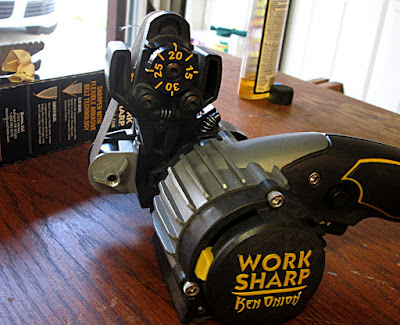If you use a knife there comes a time, regardless of the
steel, that the edge needs touching up.
Many of us return our knives the company for resharpening or take them
to a professional sharpener.
Even thinking of this brings to mind a childhood memory of an
itinerant knife sharpener on the south side of Chicago.
He had a push cart that he walked behind and sang out “knife
… scissor sharpening” as he traveled down the street. It had little bells that tinkled and jingled
as the cart rolled. He would sit at the
stone which was powered by a foot treadle and sharpen. I remember my mother with a pair of scissors
that needed sharpening as well as all the women in the neighborhood coming out
to see this old man and his grind stone.
 |
| Not the same one, but similar |
I always wondered where he came from and how he got into the
business.
Companies make all kind of sharpening aids. I had a guide that clipped on the blade of a
Buck knife and held it at constant angle.
I didn’t say correct, just constant.
Both sides are worn down from years of use. I have a Lansky that also clips on the blade
and lets you select one of several predetermined angles. The Spyderco Sharpmaker currently has two
predetermined angles, one for back beveling the blade (30 degrees) as you
sharpen into thicker and thicker steel and their standard (40 degrees) for
sharpening. Of course you can use either
angle for your sharpening your knife.
Some of us can hold a constant angle on a flat stone and
simply select an angle based on their experience. I’m not one of those, but I can free-hand a
dull edge into something significantly less dull.
The Work Sharp sharpener comes with several different grit
belts but the really attractive part is the dial-an-angle feature. Simply turn a knob to a predetermined value
and you have your angle. It’s up to you
to hold the knife against the supports to get that angle, but it’s not that
hard.
 |
| The numbers are the angle and you can swap different grit belts. The system produces what people call an appleseed or hamaguri grind |
I suspect he determined the best way to sharpen that
particular knife and not the one in your or my pocket.
Still it’s the angle you need to know. Audacious Concept, located in Lappeenranta,
Finland has the solution for you. It’s a
little dog tag that has precision cut angles from 5 to 45 degrees by
fives. Simply slip your edge into each
slit until you find the best fit. Best
fit seems to be when the edge wiggles the least in an angle.
 |
| And you get a beer bottle opener! |
You can estimate values in between if two adjacent angles
both seem to have the same wiggle.
This lets you set your sharpening system to the factory
angle or what you have discovered for your knife and use.
Sure, you could just select any angle, or you could engrave
the factory angle somewhere on each blade.
You could keep a notebook with the name and description of each knife
with the factory angle and your sharpening angle. You could do a lot of things.
Or you could just buy one of these little dog tags and keep
it with your sharpening supplies.
No comments:
Post a Comment